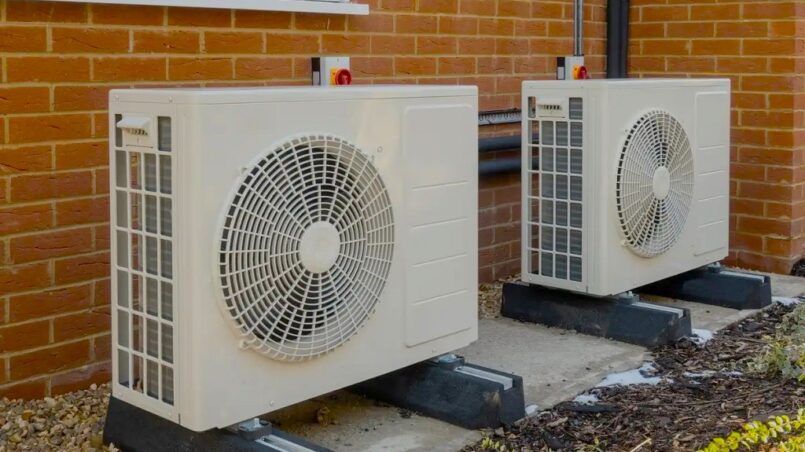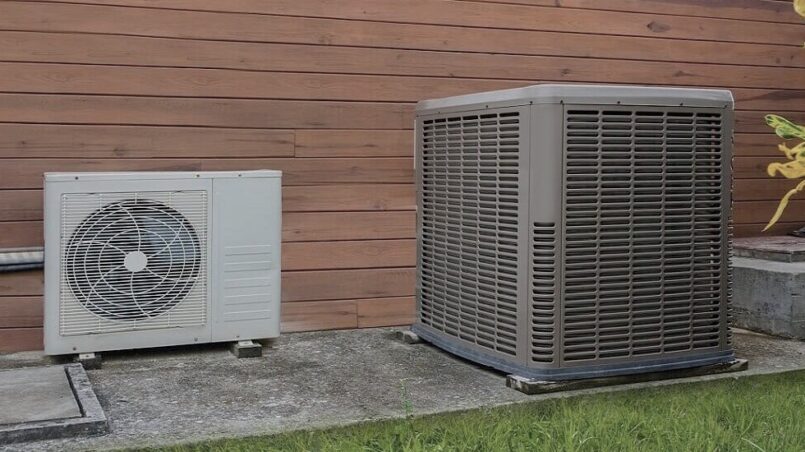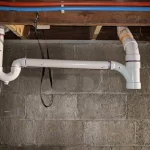Are you ready to dive deep into the fascinating world of air source heat pumps and their electricity consumption? If you’ve ever wondered, how much electricity a heat pump uses or pondered the mysteries of air source heat pump power consumption, you’re in for a treat.
In this eye-opening blog post, we’re about to unveil a real-world example that will not only pique your interest but also leave you with a burning desire to explore this efficient heating and cooling technology further. Get ready to discover the facts about how much electricity an air source heat pump uses per month and make an informed decision for your home’s energy needs. So, let’s embark on this electrifying journey together!
The Basics of an Air Source Heat Pump
Before we get into the nitty-gritty, let’s start with the basics. An ASHP is like a magical box that takes heat from the outside air (even on chilly days) and pumps it into your home. It’s like having a personal chef who can cook delicious meals with the tiniest bit of energy.
Think of it as a refrigerator in reverse. A fridge removes heat from the inside to keep your food cool. An ASHP does the opposite, pulling warmth from the outside air to heat your home. It’s all about transferring heat, not generating it from scratch, which makes it super energy-efficient.
How Much Electricity Does a Heat Pump Use?
On average, an air-source heat pump uses between 545 watts and 7,500 watts of electricity. In heating mode, a heat pump can consume between 0.86-9.00 kWh per hour, 6.86-72 kWh per day, and 205.71-2160 kWh per month.
However, heat pumps are very efficient, so they use less electricity than other types of heating and cooling systems. For example, an air-source heat pump can provide up to three times more heat energy than the amount of electricity it uses. This means that heat pumps can save homeowners a lot of money on their energy bills.
The Mysterious World of COP
COP, or Coefficient of Performance, is the secret sauce behind your ASHP’s energy efficiency. It’s like knowing the fuel efficiency of your car. The higher the COP, the less electricity your ASHP needs to work its magic.
Imagine you have two friends with cars. Friend A’s car can go 30 miles on a gallon of gas, while Friend B’s car can only go 15 miles on the same amount. Friend A’s car is clearly more efficient, right? Well, COP is the same idea, but for heating and cooling.
A typical ASHP has a COP between 2.5 and 4. In plain English, this means for every unit of electricity it consumes, it gives you 2.5 to 4 units of heating or cooling. That’s like getting a $10 pizza for just $2.50 to $4. It’s a sweet deal!
The Impact of Temperature
Now, here’s where things get interesting. The temperature outside has a big say in how much electricity your ASHP uses. It’s like how you need more energy to run in a snowstorm than on a sunny day.
When the weather is mild, say around 50°F (10°C), your ASHP works like a champ, delivering high COP and sipping electricity like a gourmet coffee. But when it’s freezing, say below 32°F (0°C), your ASHP has to work harder. It’s like your chef making a fancy feast instead of a simple salad; more energy is required.
That’s why many ASHPs come with a backup electric heating element for those icy days. It’s like your chef turning on the oven to roast a turkey. It uses more energy, but it’s necessary to keep you warm.
The Electric Bill Showdown
Alright, let’s talk numbers. How much electricity does an ASHP really use? Well, it depends on a bunch of factors:
- Size of your ASHP: Just like clothes, ASHPs come in different sizes. A larger ASHP can heat or cool a bigger space, but it might use more electricity.
- Efficiency (COP) of your ASHP: Remember that friend with the fuel-efficient car? The higher the COP, the less electricity your ASHP needs.
- Climate: Where you live matters. If you’re in sunny Florida, your ASHP won’t work as hard as it would in frigid Alaska.
- Insulation: How well your home is insulated can make a big difference. A drafty house means your ASHP has to work extra to keep you comfy.
- Thermostat settings: If you crank up the heat to sauna levels in the winter or cool your home to an arctic tundra in the summer, expect a higher bill.
In general, a household with a well-sized, well-maintained ASHP can see substantial savings on their electric bill compared to traditional heating and cooling systems like furnaces or air conditioners. It’s like switching from a gas-guzzling SUV to an electric car; you’re doing your wallet and the environment a favor.
Real-World Example
Alright, let’s get down to brass tacks. I promised you a real-world example, so here it is:
Meet Sarah and Tom. They live in a moderate climate where temperatures range from 30°F (-1°C) in the winter to 80°F (27°C) in the summer. They have a medium-sized house and installed a high-efficiency ASHP with a COP of 3.5.
During the winter, they set their thermostat to a comfortable 70°F (21°C) and run their ASHP for about 8 hours a day. In the summer, they keep it at 75°F (24°C) and use the ASHP for 6 hours a day.
Over the course of a year, their ASHP consumes approximately 6,720 kWh (kilowatt-hours) of electricity. To put that in perspective, the average American household uses about 10,000 kWh annually for all their electrical needs, including lighting, appliances, and heating or cooling.
So, Sarah and Tom’s ASHP accounts for roughly two-thirds of their annual electricity usage. But here’s the kicker: without the ASHP, they would’ve needed a traditional heating and cooling system that could have easily doubled their energy consumption.
In dollars and cents, at an average electricity rate of 12 cents per kWh, their ASHP costs them about $806 per year. If they had gone the traditional route, they could have been looking at a bill closer to $1,500 or more.
Air Source Heat Pump Power Consumption Chart
The following air source heat pump power consumption chart provides an estimated range of power consumption in watts for different sized heat pumps in heating and cooling modes, based on average efficiency ratings:
| Heat Pump Size (BTU) | Heating Mode (Watts) | Cooling Mode (Watts) |
| 12,000 | 1,000 – 7,500 | 545 – 4,286 |
| 18,000 | 1,500 – 11,250 | 818 – 6,430 |
| 24,000 | 2,000 – 15,000 | 1,091 – 8,573 |
| 36,000 | 3,000 – 22,500 | 1,636 – 12,860 |
| 48,000 | 4,000 – 30,000 | 2,182 – 17,147 |
| 60,000 | 5,000 – 37,500 | 2,727 – 21,434 |
Actual power consumption will vary depending on a number of factors, including the efficiency rating of the heat pump, the size of the home being heated or cooled, the climate, and the desired temperature setting.
It is important to note that air source heat pumps are more efficient than traditional heating and cooling systems, such as furnaces and air conditioners. This means that they can save homeowners money on their energy bills, even though they may use more watts of electricity.
Tips to Keep Your ASHP Lean and Mean
Now that you know the ins and outs of ASHP electricity usage, here are some tips to make sure your ASHP stays efficient:
- Regular Maintenance: Treat your ASHP like a prized possession. Regular maintenance keeps it running at its best. Change the filters, clean the coils, and schedule professional check-ups.
- Thermostat Love: Be mindful of your thermostat settings. A few degrees cooler in the winter and warmer in the summer can make a big difference.
- Insulation Matters: If your home is as leaky as a sieve, your ASHP has to work overtime. Invest in insulation to keep the cozy air in and the chilly air out.
- Programmable Thermostat: Consider a programmable thermostat that adjusts the temperature when you’re not at home. No need to heat an empty house, right?
- Seal Those Ducts: If your ASHP uses ducts, make sure they’re properly sealed. Leaky ducts can waste a lot of energy.
- Size Matters: Make sure your ASHP is the right size for your home. Bigger isn’t always better, as it can lead to short cycling and decreased efficiency.
Frequently Asked Questions (FAQs)
Let’s address some burning questions that may still be on your mind:
1: Can I use an ASHP in really cold climates?
Absolutely! ASHPs have come a long way, and many are designed to work efficiently in cold climates. Look for models with low-temperature capabilities or consider a dual-fuel system that switches to a backup heat source when it gets super chilly.
2: Do ASHPs work for cooling too?
You bet! ASHPs are like year-round superheroes. They can both heat and cool your home, making them versatile and energy-efficient.
3: How can I lower my ASHP’s electricity usage even more?
Besides the tips we mentioned earlier, consider using a smart thermostat that learns your habits and optimizes your ASHP’s operation. Also, don’t forget to seal those windows and doors to keep your conditioned air from escaping.
4: Are there any incentives for installing an ASHP?
Many governments and utility companies offer incentives and rebates for installing energy-efficient ASHPs. Check with your local authorities to see if you qualify for any sweet deals.
5: Can I install an ASHP myself?
While it might be tempting to DIY, it’s usually best to have a professional HVAC technician install your ASHP. They’ll ensure it’s properly sized, installed, and commissioned for optimal performance.
Conclusion
When it comes to unraveling the mysteries of how much electricity a heat pump uses, our real-world example has shed light on the matter. The numbers may seem daunting at first glance, but consider the bigger picture. Air source heat pump power consumption varies depending on several factors, including your climate, insulation, and personal habits. It’s true that these systems draw electricity, but their incredible efficiency often makes up for it.
So, if you’re pondering, “Do heat pumps use a lot of electricity?” remember that they are designed to provide comfort with minimal impact on your energy bills. Now armed with this knowledge, you can take informed steps to optimize your heat pump’s performance and make a positive impact on how much electricity a heat pump uses per month statistics.















